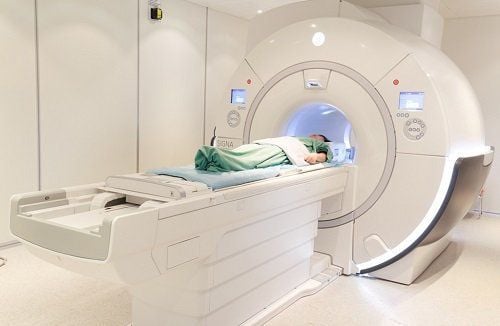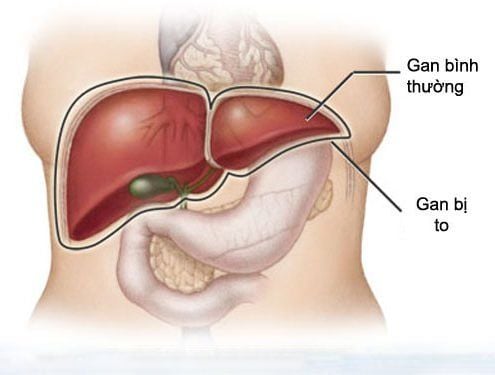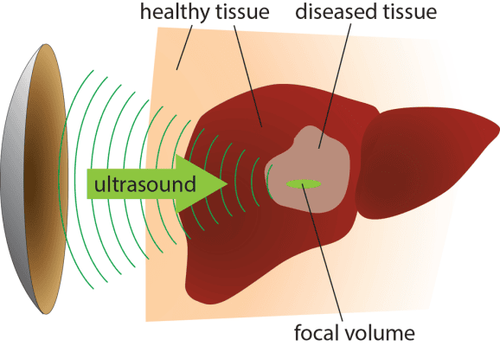This is an automatically translated article.
The article is professionally consulted with Master, Doctor Tong Diu Huong - Radiologist - Department of Diagnostic Imaging - Vinmec Nha Trang International General Hospital.The liver is an organ in the abdomen that has many important functions, including filtering blood from the intestines, secreting bile to aid in the digestion of food, metabolizing drugs, and synthesizing proteins. The vascular system, location, and functions of the liver make the liver susceptible to a number of conditions that lead to hepatomegaly, which is defined as an enlargement of the liver beyond its normal size. Hepatomegaly may be suspected based on physical examination or liver imaging.
1. What is an enlarged liver?
The liver is a wedge-shaped organ located in the right upper quadrant of the abdomen. Liver height usually extends from the fifth intercostal space to the right border at midclavicular line. On ultrasound, normal liver size is usually less than 16 cm at midclavicular line; however, liver size varies with sex and body size, as mean size measured by transabdominal ultrasound at midclavicular line is 14.5 cm for men and 13 cm for women. ,4 cm. On the other hand, liver size over 16cm is also found in about 10% of the population. In addition, a normal liver weighs 1.4 - 1.5 kg in men and 1.2 - 1.4 kg in women.Hepatomegaly is the medical term for a condition where the size of the liver is larger than normal. This is a symptom of a disease that affects the liver rather than an actual disease. Occasionally, hepatomegaly may be accompanied by other symptoms of an underlying medical condition affecting liver or other organ functions.
2. What are the symptoms of an enlarged liver?
Hepatomegaly is often a symptom of liver disease or a symptom of an underlying disease, not an underlying medical condition. When the size of the liver is significantly enlarged, the person may feel like a full stomach on the right side or discomfort in this area.In addition, the person may also experience some accompanying symptoms of potential liver problems, which may include:
Itching; Nausea; Tired; Eating poorly; Dark urine; Change in bowel habits; Unexplained weight loss; Fever.

3. What is the cause of an enlarged liver?
There are many potential causes of hepatomegaly. The most common causes include:Hepatitis: Hepatitis is the medical term for an inflammatory reaction in the liver to something that is usually caused by a viral infection or liver damage caused by alcohol. The condition can be short-term (acute) or long-term (chronic). Alcoholic liver disease: Drinking too much alcohol can lead to the accumulation of fat cells in the liver. Doctors call this fatty liver disease. Fatty levels can interfere with the liver's ability to perform important functions. In severe cases, alcoholic liver disease can lead to severe scarring of the liver or cirrhosis. Nonalcoholic fatty liver disease: This condition is also characterized by fatty liver and associated liver dysfunction. Unlike alcoholic liver disease, this is not the result of drinking too much alcohol. Instead, this is often the result of conditions such as diabetes or a diet high in fat and cholesterol. Liver cancer: Cancers that originate in the liver are called primary liver cancers, while those that have spread to the liver from other parts of the body are called secondary liver cancers. Heart failure: The portal vein is the vein that supplies blood to the liver. Heart failure can cause problems with the circulatory system that increase pressure on the portal vein. Over time, this can lead to an enlarged liver. Some doctors refer to heart-related liver problems as cardiac hepatomegaly or cardiac cirrhosis.
4. How to diagnose an enlarged liver?
There are many medical techniques that can be used to confirm hepatomegaly. A quantitative blood test for liver enzymes is the leading universal way to determine if hepatitis is ongoing. The combination of both imaging and targeted blood tests provides some insight into why the liver is enlarged.
In cases where imaging tests are needed, liver ultrasound is always the first tool indicated. This technique uses the principle of sound waves to create images of the organs in the abdomen. During the procedure, the sonographer places a device on the surface of the skin, called a transducer, that both transmits and receives sound waves. From there, the acquired images will appear on the screen, allowing the doctor to measure the size of the liver, assess the structure and elasticity of liver tissue as well as damage in the liver if any or nearby organs. Liver ultrasound is completely painless, non-invasive, simple to perform, quickly and inexpensively.
When unexplained lesions are suspected on ultrasound of the liver, the doctor may order additional imaging tests to examine the liver in more detail and complexity, including computed tomography. abdominal cavity or magnetic resonance imaging of the abdomen to examine the liver.
The above tools are all non-invasive medical techniques. Conversely, sometimes patients need invasive testing depending on the results of blood tests and specialized imaging tools. These are cases of hepatomegaly with lesions accompanied by the presence of fluid in the abdomen. At this time, the doctor may appoint laparoscopy, partly to collect fluid for analysis, partly to remove the amount of decompression fluid if it is too much. This procedure can be done at the bedside under local anesthesia.
In addition, in some critical cases, a liver biopsy will be required to reach a final diagnosis. A biopsy is also an invasive procedure in the abdomen in which a small amount of liver parenchyma is removed for microscopic examination. Like a laparoscopic procedure, a liver biopsy is often done at the bedside, using a local anesthetic, inserting a fine needle into the liver through the skin, and removing a small piece of tissue. However, in order to facilitate the technique and reduce the invasiveness for the patient, liver biopsy can be performed at the same time as laparoscopy.

5. Is an enlarged liver dangerous?
The danger of hepatomegaly depends on the cause of the enlarged liver as well as on the status of other concomitant symptoms. For example, for people with nonalcoholic fatty liver disease, an enlarged liver is not likely to pose a major health threat. However, this is seen as a sign that the person should consider making some lifestyle changes.On the contrary, if the patient has an enlarged liver with alcoholism, hepatitis B, C and D or liver cancer, it should be actively treated. However, the best way to prevent an enlarged liver is to take good care of the liver and prevent its causes, with useful ways as follows:
Use the drug with caution and with your doctor's approval doctor; Drink alcohol in moderation; Limit exposure to harmful substances, such as chemicals in cleaning products and paints; Do not share personal tools, do not share needles to avoid blood-borne infections; Using protective methods, such as condoms, during sex; Follow a healthy diet, low in saturated and trans fats; Exercise regularly; Maintain a moderate weight. Visit your doctor for a comprehensive, periodic check-up In summary, hepatomegaly is a medical term that refers to a condition in which the liver is larger than normal. This is a symptom of the disease, not the disease itself. Some of the common conditions that cause hepatomegaly including fatty liver disease, alcohol use disorders, hepatitis, and cancer, can be treated if detected early by diagnosing hepatosplenomegaly with active medical techniques at an early stage. Patients need to go to a reputable hospital to conduct examination and treatment as soon as there are signs of liver enlargement. Currently, Vinmec International General Hospital is one of the leading prestigious hospitals in the country, trusted by a large number of patients for medical examination and treatment. Not only the physical system, modern equipment: 6 ultrasound rooms, 4 DR X-ray rooms (1 full-axis machine, 1 light machine, 1 general machine and 1 mammography machine) , 2 DR portable X-ray machines, 2 multi-row CT scanner rooms (1 128 rows and 1 16 arrays), 2 Magnetic resonance imaging rooms (1 3 Tesla and 1 1.5 Tesla), 1 room for 2 levels of interventional angiography and 1 room to measure bone mineral density.... Vinmec is also the place to gather a team of experienced doctors and nurses who will greatly assist in diagnosis and detection. early signs of abnormality in the patient's body. In particular, with a space designed according to 5-star hotel standards, Vinmec ensures to bring the patient the most comfort, friendliness and peace of mind.
Please dial HOTLINE for more information or register for an appointment HERE. Download MyVinmec app to make appointments faster and to manage your bookings easily.














